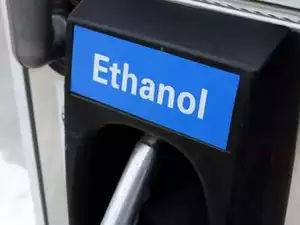Ethanol from various feedstocks must be priced adequately to help all stakeholders: Avantika Saraogi, Balrampur Chini

Avantika Saraogi, Executive Director of Balrampur Chini Mills, highlights that India has sufficient sugar for domestic use and can divert some stocks to ethanol production. She notes that sugar production for 2024-25 is expected to be lower due to yield issues in Maharashtra and Karnataka. Saraogi emphasizes the potential of sugarcane for bio-based packaging solutions, reducing fossil fuel dependence and mitigating plastic pollution. Balrampur Chini Mills is also expanding into PLA bioplastics to address sustainability challenges and market demands.
Sugarcane, found in abundance in India, has the potential to contribute significantly to bio-based packaging solutions, reducing the dependence on fossil fuels and mitigating plastic pollution, says the executive director of Balrampur Chini Mills.
iStockIndia began the sugar season 2023-24 (October to September) with an opening inventory of around 5.55 MT (million tonnes). There is enough sugar for domestic consumption and the government can divert stocks to produce ethanol, says Avantika Saraogi, Executive Director, Balrampur Chini Mills Ltd. There are some decisions that the Centre is considering to boost the growth of the industry and benefit all stakeholders, she says during an interaction with ET Digital. However, Saraogi also says the sugar production in 2024-25 is estimated to be slightly lower owing to yield and recovery, especially in Maharashtra and Karnataka. Edited excerpts:
The Economic Times (ET): How is the sugar industry performing in terms of growth for the current sugar year? Avantika Saraogi (AS): India began the sugar season 2023-24 (October to September) with an opening inventory of around 5.55 MT (million tonnes). Sugar production for the current season 2023-24 is estimated at 32 MT, around 0.8 MT lower than the previous season’s production of 32.8 MT. Current season’s production estimate is net of sugar sacrifice of around 2 MT (last season 3.8 MT) towards ethanol.
Export of sugar continued to be under restrictive list to fight inflation and an initial perception of lower production. The domestic demand for sugar is expected to be around 28.7 MT against 27.85 MT in the previous season. As a result, the carry forward stock of sugar as on September 30, 2024, is expected to be around 8.85 MT — or stock for around three and half months of consumption. There is enough sugar for domestic consumption so the government can divert sugar towards ethanol manufacturing in the upcoming season, 2024-25, to come back to the desired level of sugar inventory of 5-5.5 MT.
Avantika Saraogi, Executive Director, Balrampur Chini Mills Ltd
Sugar production for the 2024-25 season is estimated to be slightly lower owing to yield and recovery, especially in Maharashtra and Karnataka. In addition, there are few policy decisions pending at Centre level — like increase in MSP, increase in ethanol prices and policy on diversion of sugar towards ethanol in the ensuing year. A favourable decision on these will further aid in growth of the industry and its stakeholders.
ET: Sugar prices have mostly remained volatile. How does Balrampur Chini Mills (BMCL) ensure that it maintains a balanced growth trajectory, despite the constantly shifting prices?AS: At BCML, we embraced business diversification quite early in the journey. From being one of India’s largest sugar manufacturing companies, we expanded our business and ventured into verticals like distillery and cogeneration. Revenues from the distillery segment contributed nearly 26% of overall revenues in FY24 against nearly 11% in FY20 showcasing our focus on diversification and integration. Further, in February 2024, we announced an investment into the area of poly lactic acid (PLA) manufacturing. We have constantly strived to reduce our reliance on sugar. As a result of which, we not only created a sound circular economy with our product portfolio, but also ensured the percolation of the enhanced revenue from each sugarcane stick to our primary stakeholders – the farmers.
ET: India has an active ethanol-blending target to achieve. How is ethanol derived from sugarcane contributing towards achieving this target?AS: Ethanol blending has reached nearly 13.2% in this year so far, a sharp increase from nearly 1.53% in 2013-14. The government aims to achieve 20% ethanol blending by 2025-26, with 55% ethanol sourced from sugar and the balance from grains. India’s robust sugarcane industry and infrastructure play a crucial role in meeting ethanol-blending targets, which also address carbon emissions concerns. Sugarcane is undoubtedly one of the better feedstocks for ethanol production in terms of land and water usage along with emissions as compared to other crops.
BCML was the largest supplier of ethanol in the country in ESY23, with a distillery capacity of 1,050 KLPD. To significantly contribute towards the ethanol blending programme, there should not be any restriction on diversion of sugar for it — like what was imposed by the government last year. In addition, the prices of ethanol from various feedstocks needs to be compensated adequately to encourage distilleries to produce more and help the country achieve the blending targets.
ET: What drove Balrampur Chini Mills to diversify its business into PLA bioplastic manufacturing? AS: Our latest business diversification into PLA bioplastic manufacturing further demonstrates our commitment towards generating more from less. We assessed the situation and recognised the urgent need for a sustainable alternative for single-use plastics in the country. As a result, we decided to enter the nascent Indian bioplastic market, which is currently in its early stages and in need of effective intervention.
By setting up the first industrial PLA biopolymer plant, we aim to bolster the government’s efforts to reduce the nation’s energy dependence on fossil fuel. The biopolymer venture will benefit our company by optimising cane utilisation and diversifying revenue streams beyond sugar. Moreover, we recognise a vast and expanding market opportunity in PLA production, perfectly timed to meet the global demand for eco-friendly plastic alternatives.
ET: Do you think sugarcane as a crop can contribute largely towards bio-based packaging solutions? AS: Yes, sugarcane has immense potential to contribute significantly to bio-based packaging solutions. Several studies have shown that sugarcane has the highest output per area as well as per unit of water consumed. It is the most effective crop for India in producing PLA bioplastics. Additionally, sugarcane is a renewable resource, abundant in many regions of India, and can be sustainably sourced. In fact, our PLA will be made from Bonsucro certified sugarcane. By leveraging sugarcane-based bioplastics, we can reduce dependence on fossil fuels and mitigate plastic pollution. This sustainable solution aligns with India’s and global efforts to combat climate change and promote eco-friendly packaging.
Furthermore, we will expand capacity to use other starch-based crops such as maize, rice, and others — in response to any abnormal conditions presented by climate change.














